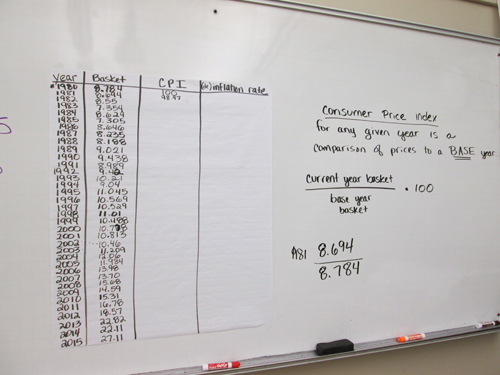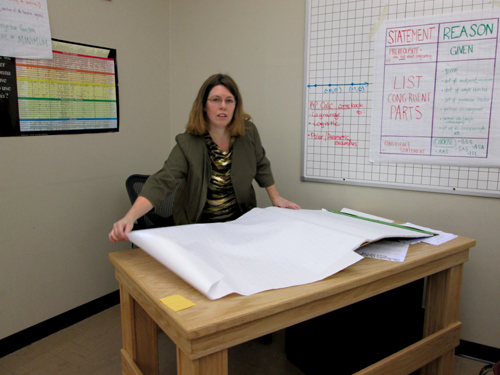Teaching Exponential Function and Inflation in Math Class
It was April 13 at 8 a.m. and 13 students gathered in Monument Mountain Regional High School’s Algebra II class. They were about to receive a lesson in mathematics in a most unconventional way.
Their teacher, Kristi Farina, was about to add economic concepts of inflation, deflation, and disinflation, as well as the Consumer Price Index into the topic of the exponential function.
An exponential function is a mathematical expression of exponential growth. Ms. Farina explained that an exponential function exhibits a rapid growth of a given variable, and in her view, the growth of prices in the economy could show exponential growth, if analyzed through a long period of time.
Now it was time to see how the economic concepts of inflation and CPI work in the real world, and if they exhibit an exponential growth quality. The class had decided on nine items to be included in their market basket. Their teacher arranged the students into groups to perform calculations with the actual data.
As the groups were forming, Ms. Farina distributed sheets of paper containing the price information from the Bureau of Labor Statistics for the nine goods in their consumer market basket, such as gasoline, bread, beef, eggs, apples, oranges, bananas, coffee, and electricity. All of those goods had a specific description from the BLS databases. For example, bread was “white, pan, per lb.” Students were fascinated to learn how precise the descriptions are and how detailed the price collection is.
The first task was to calculate the cost of market basket from 1980 to 2015. To ensure that each student was engaged with the data, each group was assigned a different time period: 1980-1993; 1994-2005; and 2006-2015.
To record the answers, the teacher used a large poster paper that she hung on the board (see picture). Soon, the whole column was filled in, and the class proceeded to calculate the CPI and then inflation.
Students observed that during the recessionary periods of 1981-1982, 1990-1991, 2001-2002, and 2008-2009, the cost of their basket showed a decline. Subsequently, the price indexes changed their value, and inflation changed to deflation.
It was interesting to see how engaged students were with an economic concept in the math class. But it was a math class after all – so at the end of this segment, the teacher connected the inflation trend to the exponential function.
The graph of the inflation rate that students constructed showed an overall growth, but not enough to illustrate the exploding growth of an exponential function. What an interesting and engaging conversation this generated! When students saw that they were analyzing a real-life phenomenon by exploring the inflation rate time series, they were curious and enthusiastic to find out if their data could be demonstrated by the exponential function.
The most amazing thing that happened during this class was the realization that the teacher, who has never taken an economics class, was using economic concepts with ease and clarity. Ms. Farina has been a math teacher for many years and has a great deal of experience explaining mathematical functions and equations.
After attending the AIER Teach-the-Teachers workshop Economics Across the Curriculum last summer, she discovered that an infusion of economic concepts into her math class would engage students, expose them to the original data source and primary data, and would make them appreciate real world applications of math.
When she came up with this lesson idea last summer she was unsure how it would go. But after the series of classes on inflation and exponential function was complete, she excitedly reported that the students mastered exponential functions, and had fun doing it.
Kristi Farina, math teacher at the Monument Mountain Regional High School in Great Barrington, Mass.
Click here to sign up for the Daily Economy weekly digest!










